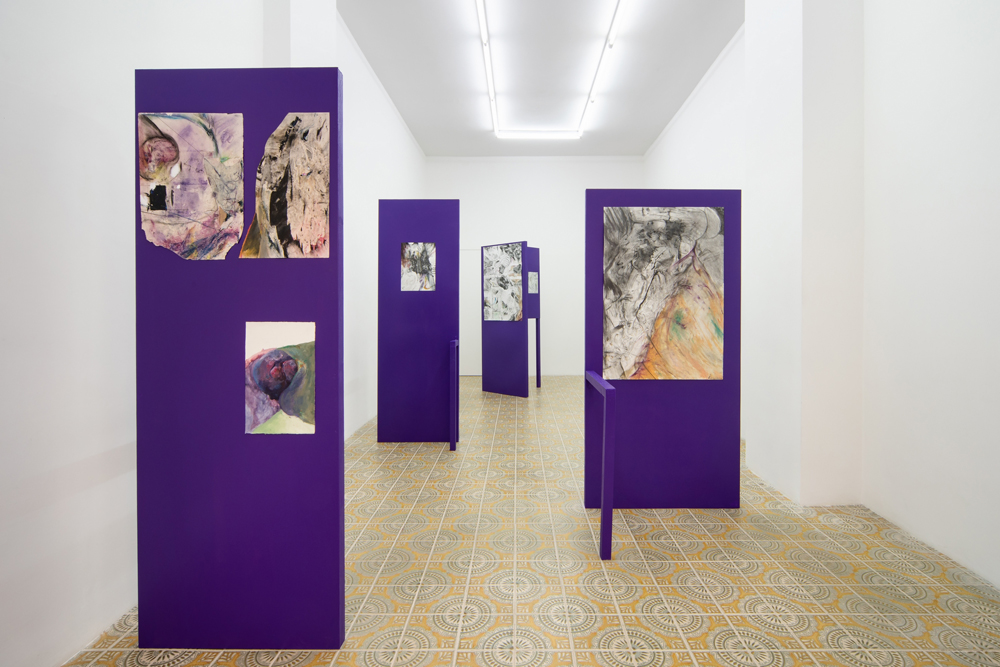Poetica del Crash,
introduzione a Bolognino generata dall’IA
A dialogue between the author and AI written for the solo show I Giganti by Andrea Bolognino at Galleria Acappella, Naples, 19 May – 20 June 2022.

Andrea Bolognino, I Giganti, installation view at Galleria Acappella, Naples, 2022. Photo: Danilo Donzelli
Courtesy Galleria Acappella and Andrea Bolognino
// ESPANDI
La sensazione, raggiunto il corpo attraverso l’organismo, assume un’andatura eccessiva e spasmodica: rompe gli argini dell’attività organica. Disfa l’organismo a vantaggio del corpo. L’opera di Bolognino inizia dalla sua inorganicità, poiché l’organismo non è la vita, è ciò che la imprigiona.

L’immagine della figura nel suo dipinto mostra una sorta di uomo “posseduto”, che vuole allontanarsi dal mondo sociale per vivere una vita “pura”, come se fuggisse dal proprio corpo, nel tentativo di fuggire dal mondo collettivo; tuttavia, la figura dell’animale che è presente a terra indica che questo desiderio non può essere esaudito: deve ritornare al corpo (alla società) dove la sua vita si sta plasmando (attraverso la sua educazione). Bolognino nacque a Firenze nel 1547, lì studiò all’Accademia del Disegno e poi partì per Roma.
// EXPAND
The sensation, when it acquires a body through the organism, takes on an excessive and spasmodic gait, exceeding the bounds of organic activity. It dismantle the organism in favor of the body. Thus Bolognino’s work finds its inorganic nature, since the organism is not life, it is what imprisons life.

This is why we must consider that the sensation is the absolute movement: “if the organism is a prison, the soul is free.” (Amor, página 31) We would like to thank all the participants who contributed to this study: Gilda D’Amato for her contribution to data collection; Cristiane Pacheco for helping with translation and revision of the manuscript; Ana Paula Barbosa, Luana Cardoso, Juliana da Fonseca, Márcia Fernandes, Aline Marques, Mariana Lima de Oliveira, Lucila Nogueira, Natália Rodrigues, Natália Santos, Fernanda Trindade, and Maria Luisa do Carmo.
// ESPANDI
Tra i molteplici riferimenti del lavoro di Bolognino, da Bosch a a Dieter Roth, è essenziale il dialogo con il Cronenberg di Crash. Il punto è che ogni dialogo intorno a orizzonti di senso è sempre assiomatico. Non è mai un dialogo. La sua base, la sua intima essenza, è il fraintendimento. Bolognino fraintende Cronenberg, come Cronenberg fraintende Ballard, ed è in questo fraintendimento reciproco che torna tutta la potenza visiva del tropo ballardiano.

“Penso che abbiamo bisogno di un nuovo tipo di film”, ha detto Cronenberg in un’intervista condotta da Bolognino, “un film che non ha personaggi ma parla piuttosto della natura della realtà”. Questo è stato scritto sul retro di uno dei libri di Cronenberg: The Antithesis. L’avevo trovato per la prima volta in una libreria di New York, dove, secondo il mio detentore del record, è ancora disponibile oggi (e ha anche una nuova copertina). A quei tempi il libro non era pubblicato in Inghilterra, ma ricordo che quando mi sono imbattuto in esso mi sono ritrovato estasiato dal solo titolo, dall’idea de L’antitesi, che mi sembrava contenesse molto di più di quanto il nome suggerisse.
// EXPAND
Among the many references of Bolognino’s work, from Bosch to Dieter Roth, the dialogue with Crash’s Cronenberg is essential. The point is that any dialogue around horizons of meaning is always axiomatic. It is never a dialogue. Its basis, its very essence, is misunderstanding. Bolognino misunderstands Cronenberg, as Cronenberg misunderstands Ballard, and it is this mutual misunderstanding that restores all the visual power of the Ballardian trope.


Notes
1 I would like to thank Professor Peter Gidal for his comments on an earlier version of this paper; and for introducing me to this new world of Crash Theory, so rich and full of life!
2 A detailed analysis of Bolognino’s text will be published by Fabrizio Piscitelli in another special issue of The Ballardian, no longer than 20 pages, entitled “Bolognino: The Poetics of the Crash”.
// ESPANDI
La poetica di Crash, imbevuto nella sua plasticità softcore, è il corpo senza organi che feticizza il desiderio come oggetto supplementare, in senso lacaniano, del rapporto sessuale. La forma e la sostanza di questa disorganicità, ellittica in quanto elitaria, lavora alla rovescia di Deleuze, e di Ballard.

Deleuze, in The Time Image, scrive: “Nella ‘classe del bello’, ciò che è coinvolto non è solo la produzione della bellezza, ma anche la possibilità dell’immagine, dell’immagine del tempo”. Deleuze fa un’interessante distinzione tra questi due tipi di immagini, entrambe prodotte dal moderno sistema capitalista come mezzo principale di regolazione del desiderio (il corpo senza organi per il primo, l’immagine del tempo per il secondo). Per Deleuze c’è una differenza radicale tra i due.
// EXPAND
Crash’s poetics, imbued with its softcore plasticity, is the organless body that fetishizes desire as an additional object, in the Lacanian sense, of sexual intercourse. The form and substance of this disjointedness, elliptical as it is elitist, works in the reverse of Deleuze and Ballard.

In a word, ‘crash’— the term for “a sudden failure of a machine” — is an aesthetic rather than an ontological category; a kind of high-art, avant-garde sensibility to which the very concept of the desiring body might be said to belong: “A body without organs”, as one character calls another in the film, and we see what he means when the scene ends with the other’s sculpted torso floating on a bed of shards like a cosmic egg.
// ESPANDI
Lo sguardo di Bolognino, organizzato per livelli, come davanti ad uno scheletro del Museo di Paleontologia, percorre lo spazio e il limite del corpo senza organi sullo stesso piano di Deleuze: il divenire-macchina dell’umano.

“Davanti allo scheletro mi sono sentito di nuovo solo” (Bolognini). #### **2** Questo dualismo tra macchina ed esseri organici è presente anche nel dipinto Io e il mio corpo, dove si vede l’immagine del corpo diviso in due parti, con una sorta di qualità meccanica: il busto, costituito da tubi con arti articolati, è racchiuso in un contenitore a forma di uovo che simboleggia il corpo, mentre il viso appare fuori dall’uovo e sopra di esso, come un guscio d’uovo.
// EXPAND
Bolognino’s gaze, organized by levels, as in front of a skeleton in the Museum of Paleontology, travels the space and the limit of the body without organs on the same plateau as Deleuze: the becoming-machine of the human.

The sight of a dead animal in the museum allows one to understand how man is the product of evolution (the skeleton) and also of an accident (the death).
The Bolognino’s work, at the same time, makes him an important precursor of the neo-expressionists such as Jackson Pollock, and he remains, however, a modern artist of great originality who has been able to maintain an originality without any compromise for the sake of fashion, as we have seen from his work Esprit de corps, with its references to cubism.
// ESPANDI
L’irruzione della macchina nel corpo, e viceversa del corpo nella macchina, elude i termini metaforici della vecchia e noiosa questione delle “macchine che sostituiscono gli esseri umani”. L’interrogativo autentico che si pone l’arte di Bolognino, nella sua profonda umanità, non è dunque “come possono eventualmente le macchine imitare la mente umana?”, bensì “in che modo l’identità stessa della mente umana poggia su supporti meccanici esteriori?”

Lo sviluppo di un nuovo tipo di simbiosi corpo/macchina – che non è ancora una cosa ma potrebbe essere solo un’idea il cui tempo è giunto – non siamo affatto sicuri che diventerà un realtà reale, ma alcune persone pensano che potrebbe accadere nella loro vita, mentre altri credono che l’idea non possa diventare realtà in questo secolo perché la tecnologia dovrebbe avanzare così tanto prima di essere in grado di supportare un tale cambiamento, che il mondo dovrebbe essere prima distrutto.
// EXPAND
The break-in of the machine into the body, and vice versa of the body into the machine, does not then take place in the metaphorical terms of the old and boring question of “machines replacing human beings”. The real question posed by Bolognino’s art, in its profound humanity, is therefore not “how can machines possibly imitate the human mind?”, But “how the very identity of the human mind rely on external mechanical supplements?”

In his 1958 essay Machine and Human thought, Bolognino lies the question in a fundamental insight into the nature of reality itself: that reality is a process of continuous change and that it is only our view of this reality that keeps us alive as individuals; when we become aware of this fact we can let go of the idea that there must be something about us that is immutable and unchanging – our minds – which makes us special among all other living creatures – and discover that we are just one part of a bigger whole, the universe, which has no beginning and no end.
// ESPANDI
Di fronte al progressivo concretarsi della distopia apocalittica, dal segno di Bolognino emerge, in una sorta di pulviscolo oracolare, un paesaggio di by-pass dei sensi, di sistemi neuronali direttamente saldati alla rete informatica. Qui, il nuovo cyber umano può finalmente dissolvere il patriarcato dell’ego identitario nel puro svuotamento di una soggettività priva di sostanza.

In questo scenario, il cyberspazio diventa l’unico spazio che rende possibile la piena espressione dell’uomo nella sua libertà, e il CH (Cyber Human) sarà dotato di tutti i poteri della futura rivoluzione cibernetica, che mira a creare un’intelligenza artificiale (AI) capace di auto-riproduzione, e quindi di moltiplicazione indefinita in una rete di reti.
// EXPAND
Faced with the progressive realization of the apocalyptic dystopia, from the sign of Bolognino emerges, in a sort of oracular dust, a landscape of by-pass of the senses, of neuronal systems directly welded to the computer network. Here, the new cyber human can finally dissolve the patriarchy of the identity ego in the pure emptying of a subjectivity devoid of substance.

We are not just here for ourselves: we live only because there is someone else there with whom to share our life together, which means that we must be prepared to sacrifice some part of our existence for others, and that we do so without any sense of guilt or self-loathing (see Lacan). The neurotic is the one who does not know how to give up this illusion of selfishness; he is the one who lives within himself alone, without taking account of the other and is therefore incapable of love.
